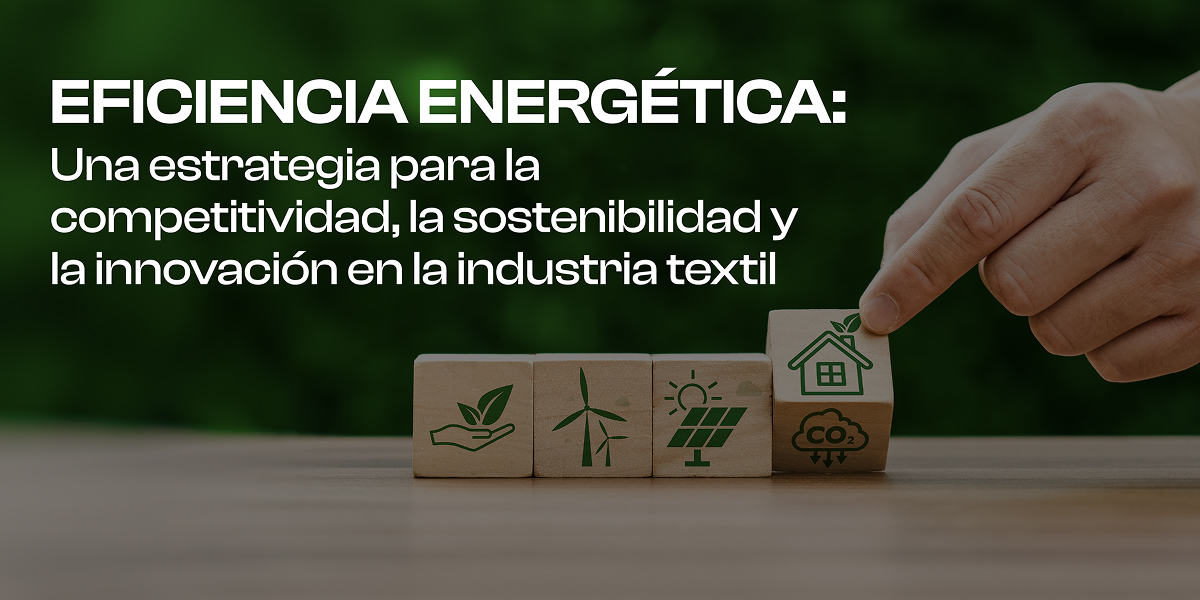Investing in energy efficiency in industry is a strategic decision that boosts sustainable development and improves the performance of companies at all levels. Optimizing energy use not only helps to reduce costs, but also strengthens the environmental commitment of companies, facilitates regulatory compliance and improves the perception of the sector in international markets. This is especially true in the eyes of potential customers and business partners. In an increasingly demanding global environment with regard to the environmental performance of supply chains, energy efficiency is a key differentiator for companies seeking to strengthen their competitiveness and position themselves as leaders in sustainability and innovation.
Why focus on energy efficiency?
Energy efficiency consists of making better use of the energy resources used in production processes, generating the same result with less consumption. In the textile industry, efficiency is directly related to higher productivity, cost reduction and lower environmental impact.
The textile industry is no exception. Although it has been working with traditional energy savings such as the application of more efficient motors, electricity generation with solar panels, shorter and more effective process times, there is one resource that should be considered a priority: the technification of labor and the professionalization of resource management to improve energy consumption during production processes. There is a resource that should be considered a priority, the technification of labor and the professionalization of resource management to improve energy consumption during production processes.
Implementation: where to start?
Energy efficiency does not require drastic transformations from the outset. In fact, many actions can be initiated with moderate investments.

Energy saving strategies in the textile industry
In the textile industry, each stage of the production process represents key opportunities to optimize energy consumption. The combination of efficient technology, preventive maintenance, automation and personnel training can generate significant impacts on both the sustainability and profitability of the sector.
Spinning
Energy savings start from the preparation of the yarn. Some recommended practices include:
- Proper sorting of cotton bales.
- Regulation of the electric flow to avoid variation in the regularity of the denier in the synthetic yarn.
- Proper maintenance and cleaning of draw frames.
- Statistical control of yarn strength (% of irregularities in the continuity of yarn formation).
- Professionalization of the quality testing laboratory.
- Moisture percentage regulation in the final packaging.
Weaving (knitting and weaving)
This stage consumes electrical energy continuously due to the operation of looms and circular knitting machines. Suggested actions are:
- Use of high efficiency motors (IE3 or IE4).
- Preventive maintenance to reduce losses due to friction or wear.
- Automation of speed and tension parameters in real time.
- Manual or automated tension control to improve production efficiency.
- Machine speed controls and statistical analysis to detect areas for improvement.
- Technical training to improve the reaction capacity of specialized mechanics, which is key to operational efficiency.
Dyeing, printing and finishing
These phases require high levels of thermal and electrical energy. The following actions can improve energy performance:
- Application of chemical solutions for dyeing processes to reduce energy consumption without compromising quality.
- Heat recovery through economizers.
- Optimization of the use of boilers.
- Precise control of temperature and dyeing times.
- Efficient hot water management.
- Consideration of rheology in printing, which reduces the use of pigments and chemicals, improves quality and reduces the inorganic load in effluents.
- Technical training to correctly evaluate moisture in drying processes.
- Technical regulation of inputs such as softeners and special finishes to avoid waste.
Garment washing
Washing can represent a high consumption if not properly managed. Key recommendations:
- Use of efficient heating systems.
- Washing programs optimized according to the load and type of fabric.
- Implementation of equipment with low water and energy consumption.
Sublimation and screen printing
Both processes depend on heat and, in the case of screen printing, also on lighting and pneumatic equipment. To save energy:
- Use curing ovens with efficient thermal insulation.
- Incorporate LED lighting in work areas and tables.
Other areas with the potential to contribute to energy savings:
Process logistics can generate invaluable savings when performed in an organized manner, seeking to improve deliveries to the end customer. Avoid reprocesses by implementing systems such as Kaizen, Lean Six Sigma, RFT (Right First Time) or any other system that avoids repeating work in the process.
Support and management processes
- Process logistics can be optimized to generate significant savings if managed with a focus on efficient delivery to the customer.
- Implementing continuous improvement methodologies such as Kaizen, Lean Six Sigma or RFT (Right First Time) helps to reduce reprocesses that consume additional energy.
Energy saving opportunities in industry
Energy efficiency in the textile industry is an essential step towards sustainability. It not only contributes to reducing costs and emissions, but also to building a more resilient and competitive industry.
More and more textile and apparel companies are investing in their own renewable energy installations, such as solar panels, to provide some or all of the energy they require. This not only reduces their dependence on fossil fuels, but also reduces their greenhouse gas emissions.
Other measures that can be implemented to improve energy efficiency include replacing standard motors with high-efficiency models to reduce energy consumption. In thermal processes such as dyeing or drying, thermal insulation and the use of economizers to recover heat can improve boiler efficiency.
Likewise, upgrading traditional systems to LEDs can mean savings of up to 60% in electricity consumption, in addition to improving the quality of lighting in the plants.
In addition to implementing these actions, companies in the apparel and textile sector can install systems that allow real-time monitoring of electrical, thermal or pneumatic consumption to help identify opportunities for improvement and make informed decisions.
At VESTEX, we actively promote an efficient, responsible and modern apparel and textile industry. Through training programs, dissemination of best practices and alliances with experts, we drive the energy transformation of the sector.
Our commitment is to accompany companies in the adoption of solutions adapted to their processes, ensuring not only compliance with current regulations, but also a comprehensive improvement in their economic and environmental performance.
Energy efficiency is not a challenge, but an opportunity. An industry that manages its energy resources better is a more profitable, sustainable and future-proof industry.
Investing in energy efficiency is investing in innovation, in compliance, in reputation and in strengthening the sector. At VESTEX, we celebrate every step towards more efficient production and reiterate our commitment to continue driving a positive transformation in the Guatemalan apparel and textile industry.


